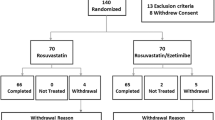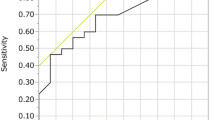Abstract
Introduction
The effects of a low dose of rosuvastatin (ROS) and pitavastatin (PIT) on lipid profiles and inflammation markers were assessed in subjects with type 2 diabetes mellitus.
Methods
A total of 90 Japanese type 2 diabetes patients with hyperlipidemia (low-density lipoprotein cholesterol [LDL-C] ≥140 mg/dL) were enrolled in this study. They were randomly assigned to four groups with open-label treatment with ROS (2.5 mg daily) or PIT (2 mg daily); two groups were sequentially treated with both drugs, with crossover of medication after 12 weeks, and the other two groups underwent treatment with either ROS or PIT for 24 weeks. The primary endpoints were the percentage changes in LDL-C, high-density lipoprotein cholesterol (HDL-C) and triglyceride, and the LDL-C/HDL-C ratio.
Results
Both ROS and PIT lowered LDL-C and triglyceride, and increased HDL-C. In particular, significantly greater reduction in LDL-C was seen with ROS (−44.1%) than with PIT (−36.9%, P<0.01) in the crossover group from ROS to PIT, and the same result was detected in the crossover group from PIT (−34.8%) to ROS (−44.7%). The ratio of LDL-C/HDL-C was significantly reduced with ROS treatment (from 3.45 to 1.85) compared with that with PIT (from 3.45 to 2.22, P<0.01). Both ROS and PIT lowered plasma levels of highsensitivity C-reactive protein (hsCRP), tumor necrosis factor (TNF)-alpha, and plasminogen activator inhibitor-1 (PAI-1). In addition, the hsCRP level with the administration of ROS was significantly improved compared with the administration of PIT. There was no significant correlation between changes in LDL-C and hsCRP, TNF-alpha, and PAI-1 levels. ROS and PIT did not have an adverse effect on glycemic control in type 2 diabetes patients.
Conclusion
Therapy with both statins improved lipid profiles and reduced proinflammatory responses; however, 2.5 mg of ROS have a potent LDL-C-lowering and hsCRP-lowering effect compared with 2 mg of PIT in patients with diabetes.
Similar content being viewed by others
References
Greving JP, Denig P, Ceeuw D, Bilo HJK, Haaijer-Ruskamp FM. Trend in hyperlipidemia and hypertension management in type 2 diabetes from 1998–2004: a longitudinal observational study. Cardiovasc Diabetol. 2007;6:25.
Colhoun HM, Betteridge DJ, Dumington PN, et al. Primary prevention of cardiovascular disease with atorvastatin in type 2 diabetes in the collaborative atorvastatin diabetes study (CARDS): multicentre randomized placebo-controlled trial. Lancet. 2004;364:685–696.
Betteridge J. Benefits of lipid-lowering therapy in patients with type 2 diabetes mellitus. Am J Med. 2005;118(Suppl. 12A):10–15.
Nicholls SJ, Tuzcu EM, Sipahi I, et al. Statins, highdensity lipoprotein cholesterol, and regression of coronary atherosclerosis. JAMA. 2007;297:499–508.
Ridker PM, Danielson E, Fonseca FA, et al. Rosuvastatin in C-reactive protein and LDL cholesterol and cardiovascular event rates after initiation of rosuvastatin: a prospective study of the JUPITER trial. Lancet. 2009;373:1175–1182.
Saito Y, Yamada N, Teramoto T, et al. A randomized, double-blind trial comparing the efficacy and safety of pitavastatin versus pravastatin in patients with primary hypercholesterolemia. Atherosclerosis. 2002;162:373–379.
Effects of pitavastatin, 3-hyfroxy-3-methylglutaryl coenzyme a reductase inhibitor, on cardio-ankle vascular index in type 2 diabetic patients. J Atheroscler Thromb. 2009;16:539–545.
Arai H, Hiro T, Kimura T, et al. More intensive lipid lowering is associated with regression of coronary atherosclerosis in diabetic patients with acute coronary syndrome—sub-analysis of Japan-ACS study. J Atheroscler Thromb. 2010;17:1096–1107.
Sever PS, Poulter NR, Dahlof B, et al. Reduction in cardiovascular events with atorvastatin in 2,532 patients with type 2 diabetes: Anglo-Scandinavian Cardiac Outcomes Trial-lipidlowering arm (ASCOT-LLA). Diabetes Care. 2005;28:1151–1157.
Peters SAE, Palmer MK, Grobbee DE, et al. C-reactive protein lowering with rosuvastatin in the METEOR study. J Intern Med. 2010;268:155–161.
Wlodarczyk J, Sullivan D, Smith M. Comparison of benefits and risks of rosuvastatin versus atorvastatin from a meta-analysis of head-tohead randomized controlled trials. Am J Cardiol. 2008;102:1654–1662.
Yokote K, Bujo H, Hanaoka H, et al. Multicenter collaborative randomized parallel group comparative study of pitavastatin and atorvastatin in Japanese hypercholesterolemic patients. Collaborative study on hypercholesterolemia during intervention and their benefits for atherosclerosis prevention (CHIBA study). Atherosclerosis. 2008; 201:345–352.
Toi T, Taguchi I, Yoneda S, et al. Early effect of lipidlowering therapy with pitavastatin on regression of coronary atherosclerotic plaque-comparison with atorvastatin-. Circ J. 2009;73:1466–1472.
Teramoto T, Sasaki J, Uematsu H, et al. Executive summary of Japan Atherosclerosis Society (JAS) guideline for diagnosis and prevention of atherosclerotic cardiovascular disease for Japanese. J Atheroscler Thromb. 2007; 14:45–50.
Ridker PM, Rifai N, Rose L, Buring JE, Cook NR. Comparison of C-reactive protein and low-density lipoprotein cholesterol levels in the prediction of first cardiovascular events. N Engl J Med. 2002; 347:1557–1565.
Wang TJ, Nam BH, Wilson PW, et al. Association of C-reactive protein with carotid atherosclerosis in men and women: The Framingham Heart Study. Arterioscler Thromb Vasc Biol. 2002;22:1662–1667.
Hashimoto K, Kasayama S, Yamamoto H, Kurebayashi S, Kawase I, Koga M. Strong association of C-reactive protein with body mass index and 2-h post-challenge glucose in non-diabetic, nonsmoker subjects without hypertension. Diabet Med. 2004;21:581–585.
Ross R. Atherosclerosis — an inflammatory disease. N Engl J Med. 1999;340:115–126.
Taniguchi A, Nagasaka S, Fukushima M, et al. C-reactive protein and insulin resistance in non-obese Japanese type 2 diabetic patients. Metabolism. 2002;51:1578–1581.
Tsunoda K, Arita M, Yukawa M, et al. Retinopathy and hypertension affect serum high-sensitivity C-reactive protein levels in type 2 diabetic patients. J Diabetes Complications. 2005;19:123–127.
Koshiyama H, Taniguchi A, Tanaka K, et al. Effects of pitavastatin on lipid profiles and high-sensitivity CRP in Japanese subjects with hypercholesterolemia: Kansai investigation of statin for hyperlipidemic intervention in metabolism and endocrinology (KISHIMEN) investigators. J Atheroscler Thromb. 2008;15:345–350.
Motomura T, Okamoto M, Kitamura T, et al. Effects of pitavastatin on serum lipids and high sensitivity C-reactive protein in type 2 diabetes patients. J Atheroscler Thromb. 2009;16:546–552.
Qu HY, Xiao YW, Jiang GH, et al. Effect of atorvastatin versus rosuvastatin on levels of serum lipids inflammatory markers and adiponectin in patients with hypercholesterolemia. Pharm Res. 2009;26:958–964.
Gomez-Garcia A, Martines Torres G, Ortega-Pierres LE, Rodriguez-Ayala E, Alvarez-Aguilar C. Rosuvastatin and metformin decrease inflammation and oxidative stress in patients with hypertension and dyslipidemia. Rev Esp Cardiol. 2007;60:1242–1249.
Bellia A, Rizza S, Galli A, et al. Early vascular and metabolic effects of rosuvastatin compared with simvastatin in patients with type 2 diabetes. Atherosclerosis. 2010;210:199–201.
Laumen H, Skurk T, Hauner H. The HMGCoA reductase inhibitor rosuvastatin inhibits plasminogen activator inhibitor-1 expression and secretion in human adipocytes. Atherosclerosis. 2008;196:565–573.
Ohbayashi H. Pitavastatin improves serum resistin levels in patients with hypercholesterolemia. J Atheroscler Thromb. 2008;15:87–93.
Takebayashi K, Suetsugu M, Matsumoto S, Aso Y, Inukai T. Effects of rosuvastatin and colestimide on metablic parameters and urinary monocyte chemoattractant protein-1 in type 2 diabetic patients with hyperlipidemia. South Med J. 2009;102:361–368.
Tsutamoto T, Yamaji M, Kawahara C, et al. Effect of simvastatin vs. rosuvastatin on adiponectin and haemoglobin A1c levels in patients with nonischaemic chronic heart failure. Eur J Heart Failure. 2009;11:1195–1201.
Yamakawa T, Takano T, Tanaka S, Kadonosono K, Terauchi Y. Influence of pitavastatin on glucose tolerance in patients with type 2 diabetes mellitus. J Atheroscler Thromb. 2008;15:269–275.
Inami N, Nomura S, Shouzu A, et al Effects of pitavastatin on adiponectin in patients with hyperlipidemia. Pathophysiol Haemost Thromb. 2007;36:1–8.
Author information
Authors and Affiliations
Corresponding author
Rights and permissions
About this article
Cite this article
Yanagi, K., Monden, T., Ikeda, S. et al. A crossover study of rosuvastatin and pitavastatin in patients with type 2 diabetes. Adv Therapy 28, 160–171 (2011). https://doi.org/10.1007/s12325-010-0098-2
Received:
Published:
Issue Date:
DOI: https://doi.org/10.1007/s12325-010-0098-2




